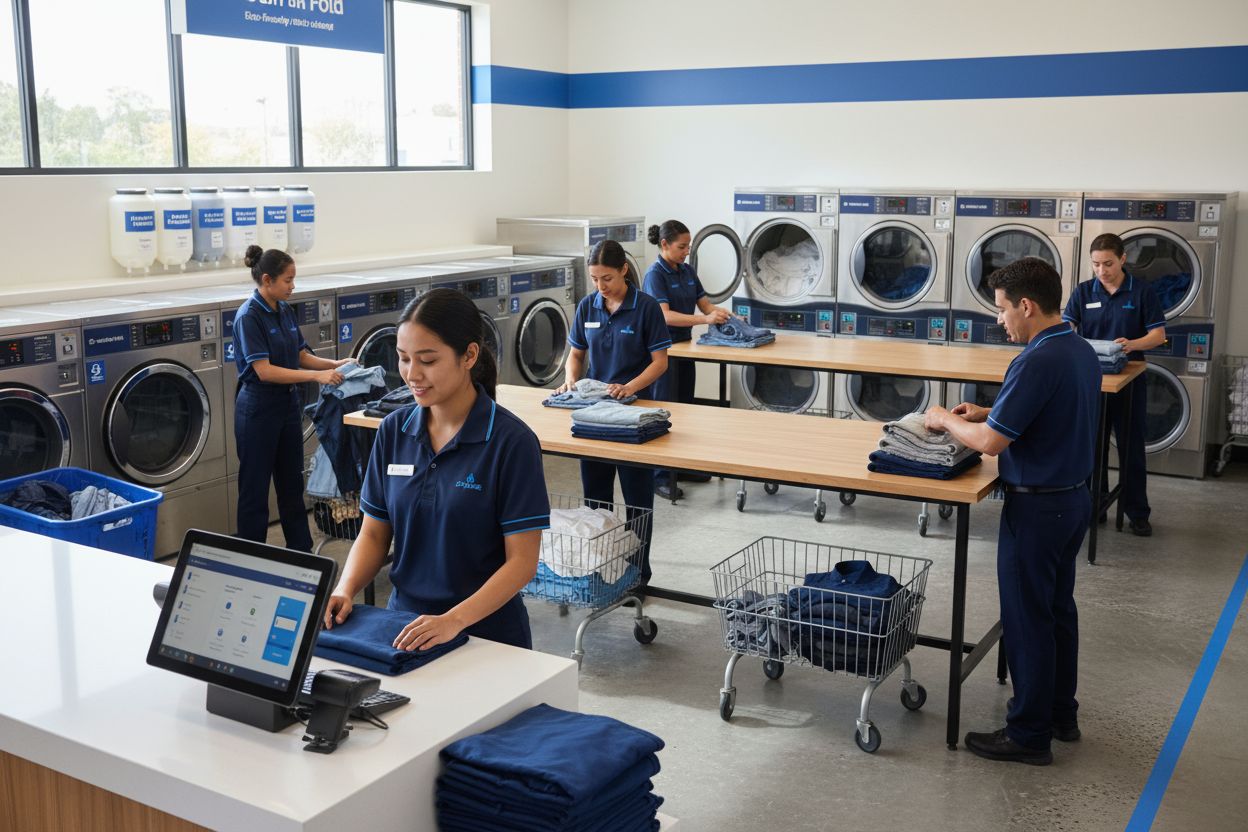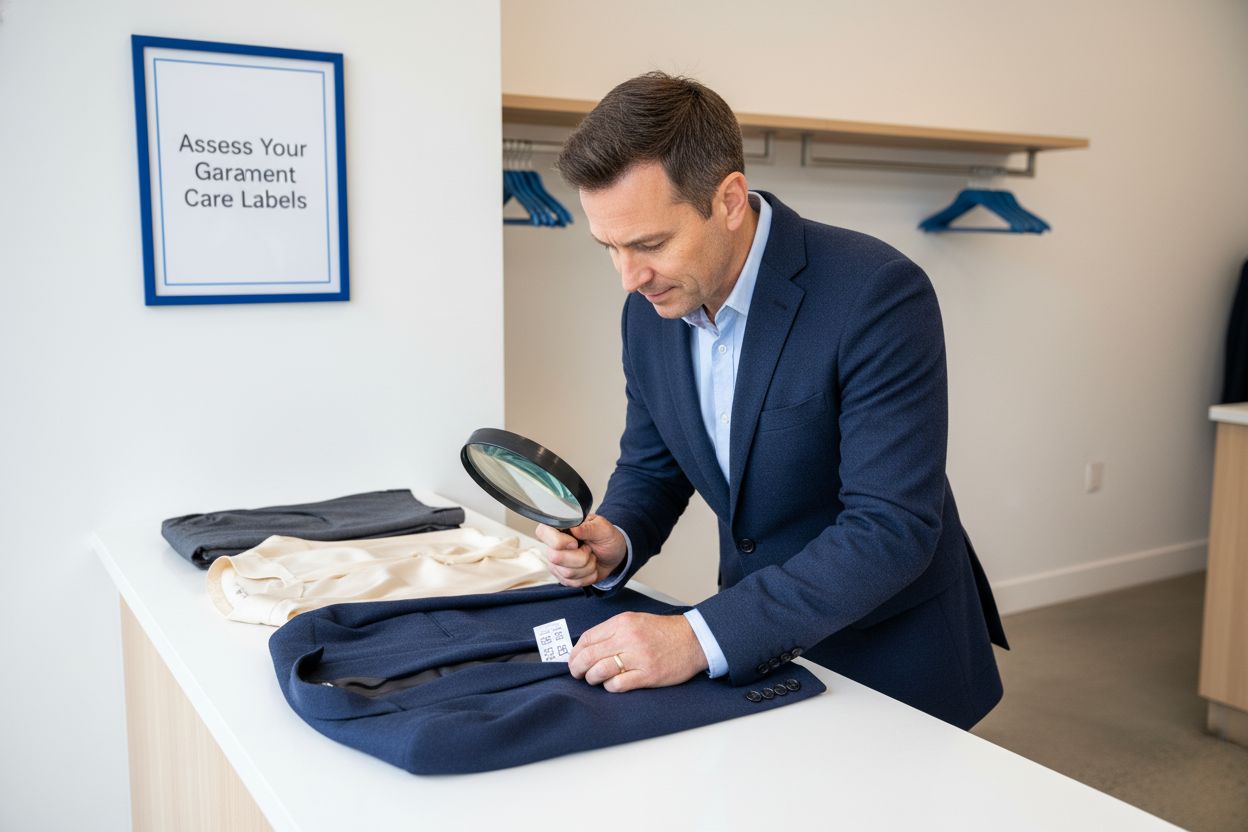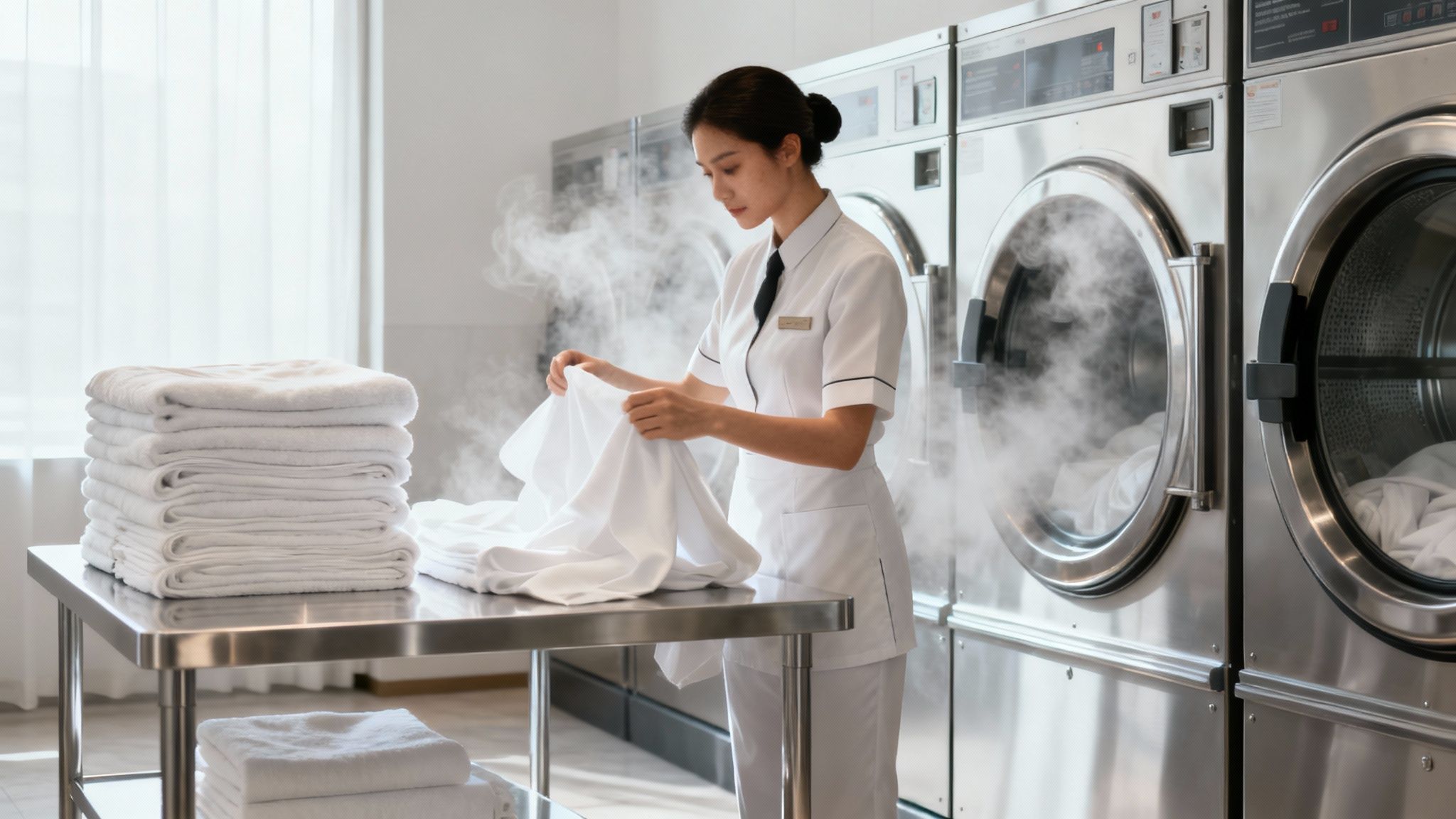What Causes Fabric Pilling and How to Stop It
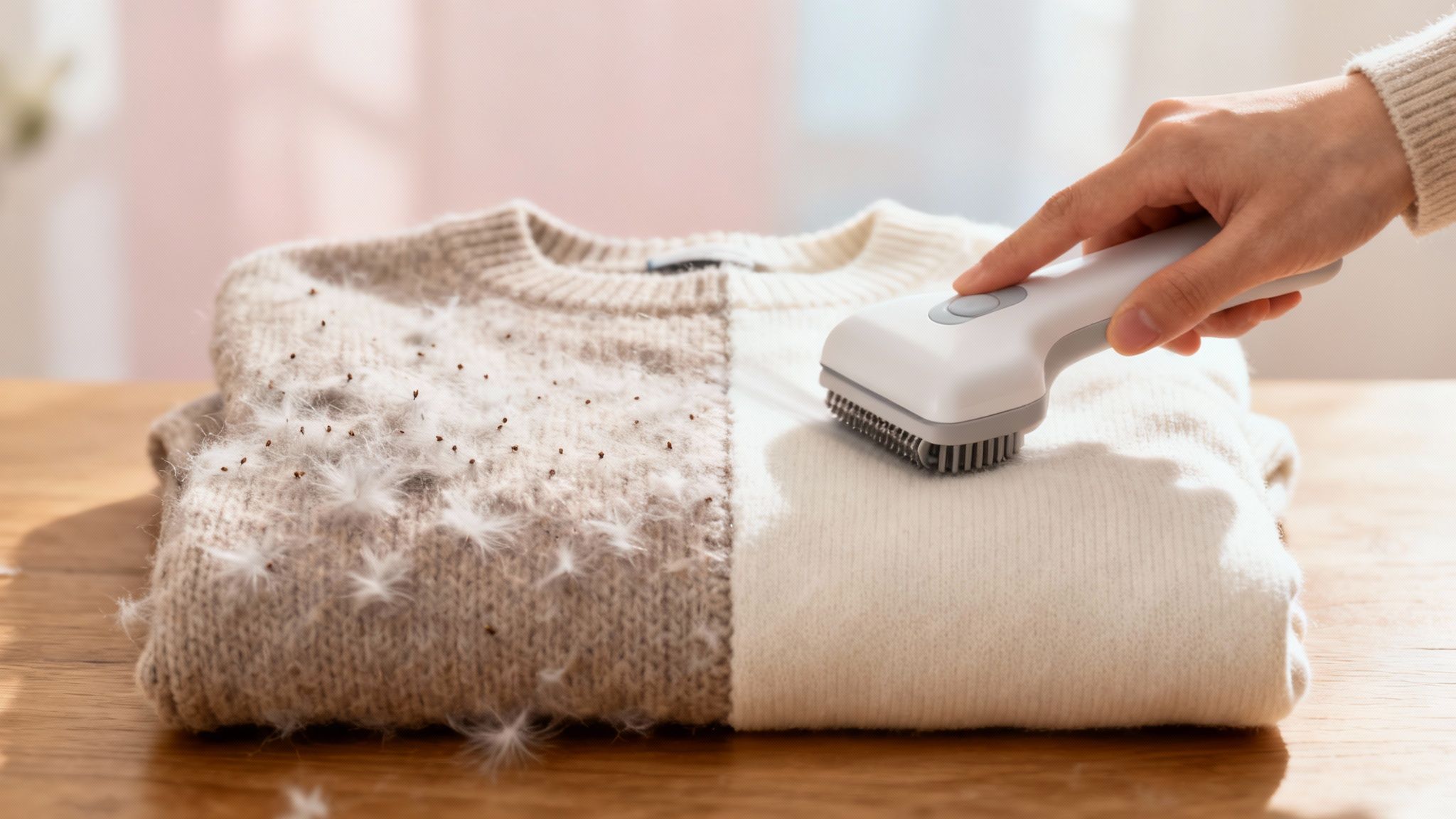
If you've ever wondered why your favorite sweater suddenly looks old and fuzzy, the simple answer is friction. When the fibers on a fabric's surface rub against something—whether it's another part of the garment, your skin, or a backpack—they can break loose, get tangled up, and form those little bumps we all love to hate. We call them pills.
Think of it like a rope that starts to fray after being used over and over. The same basic principle is at work on your clothes and furniture.
The Three Core Causes of Fabric Pilling
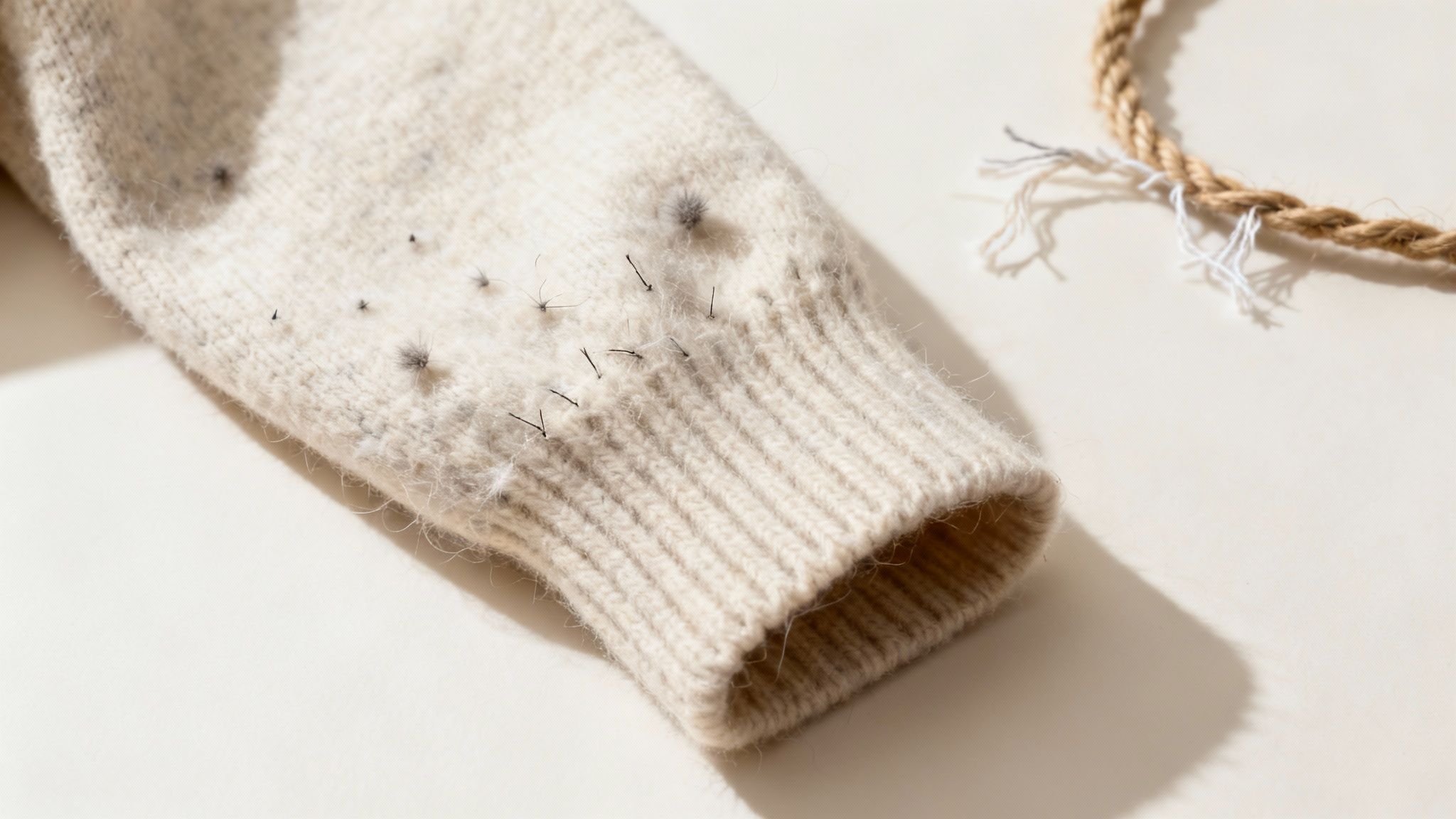
While friction is the immediate trigger, the real story behind pilling involves a few key factors working in tandem. Getting a handle on these is the first step to keeping your fabrics looking smooth and new for longer. It's a huge part of understanding fabric wear and tear and figuring out why some clothes seem to give up the ghost so much faster than others.
Let's break down the main culprits you need to be aware of.
Key Factors at Play
There are really three things that determine whether a fabric will turn into a pilled-up mess.
- The Type of Fiber: Not all fabrics are created equal in the pilling department. Materials made from short, "staple" fibers (like cotton, wool, and acrylic) have millions of tiny ends just waiting to pop out and tangle. On the flip side, fabrics made from long, continuous "filament" fibers (like silk or Lyocell) are naturally much smoother and less prone to pilling.
- Everyday Abrasion: This is the most obvious cause—plain old mechanical stress. You’ll almost always see pilling show up first in high-friction zones. Think under the arms of a sweater, on the sides of a shirt where a seatbelt or purse strap rubs, or between the thighs on a pair of pants.
- Your Laundry Routine: Your washing machine can be a pilling paradise. The tumbling and agitation create a ton of friction, and when you add the high heat of a dryer, you've got the perfect storm for fibers to break, get fuzzy, and ball up. This can speed up the pilling process like nothing else.
For a quick reference, here’s how these three factors stack up.
The Three Main Causes of Fabric Pilling at a Glance
Once you see how these three elements work together, you're in a much better position to make smarter choices—from what you buy to how you wear and wash it.
Why Some Fabrics Pill More Than Others
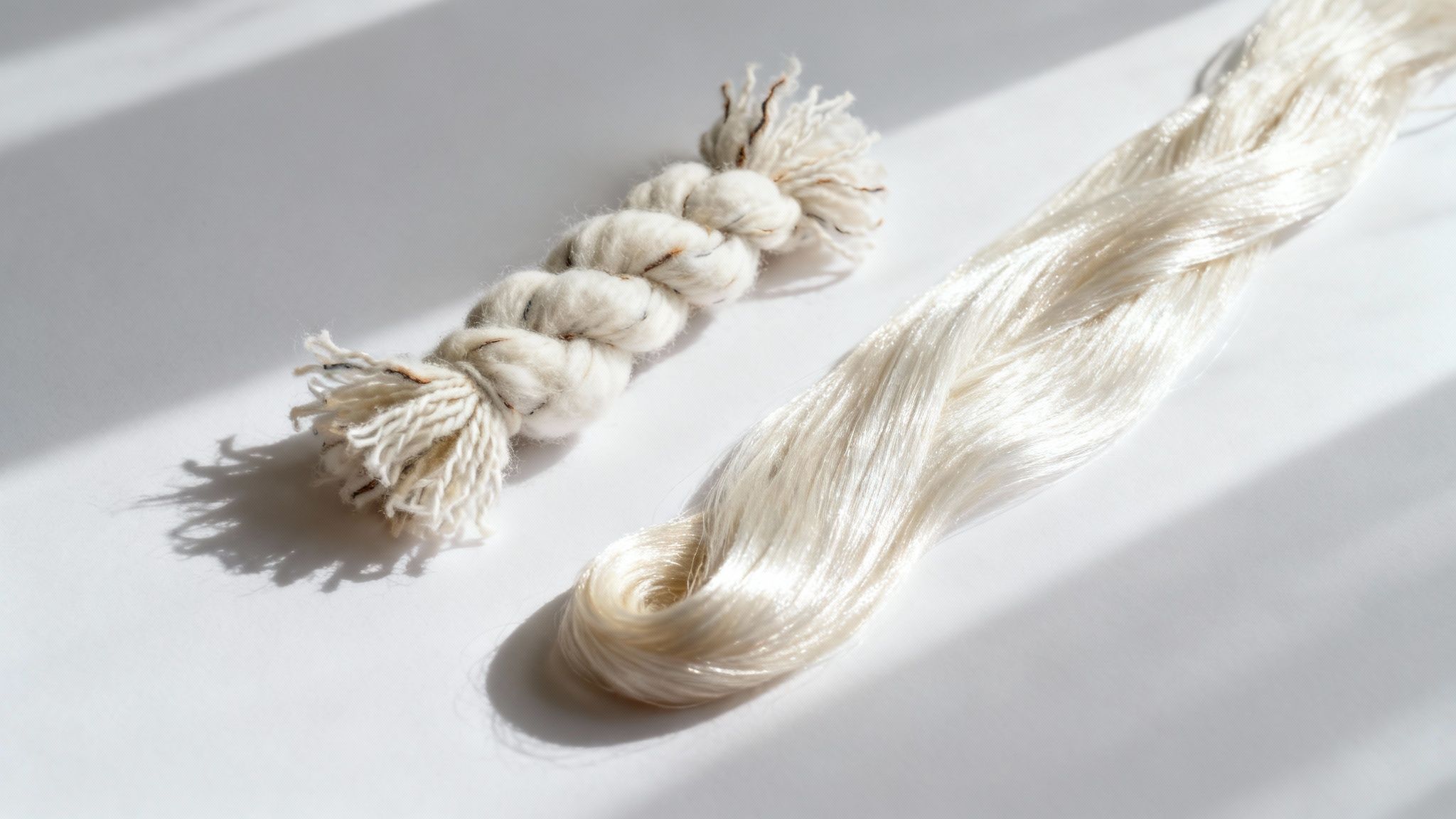
Ever wondered why a cozy fleece jacket starts looking fuzzy almost immediately, while a silk shirt stays perfectly smooth for years? The secret is hidden in the microscopic fibers that make up the yarn. When it comes to pilling, the single biggest factor is fiber length.
Think about it like trying to make a rope. If you use thousands of tiny, short pieces of string, you're going to have countless little ends poking out everywhere. It only takes a little bit of rubbing for those ends to get loose and tangle up. That’s precisely what happens with fabrics made from short staple fibers—think cotton, wool, and many of the synthetics we wear every day.
Now, imagine making that same rope from one single, incredibly long strand. There are almost no ends to pop out, which makes for a much smoother and more durable rope. This is the simple principle behind filament fibers. Silk is a perfect natural example; its long, continuous structure gives it a built-in resistance to pilling.
The Role of Fiber Strength and Weave
While fiber length is king, the strength of those fibers and the way they’re woven together also have a huge say in the matter. This is why a tough synthetic like polyester can still be a major pilling culprit.
- Strong Fibers Anchor Pills: Here’s the catch with strong synthetic fibers—they don't break off easily. So when a pill does form, these tough fibers act like tiny anchors, holding that fuzzball securely to the surface instead of letting it shed.
- Loose Weaves Invite Friction: Knitted fabrics, like the ones used for sweaters and activewear, naturally have a looser structure than tightly woven materials. This extra space gives the fibers more room to wiggle around, rub against each other, and ultimately, form those annoying little pills.
It's no surprise that knits, which make up over 60% of casual and activewear, can pill up to three times faster than tightly woven fabrics. This isn't necessarily a sign of poor quality, but a natural result of how they're constructed.
Of course, how we care for our clothes is a huge piece of the puzzle. Aggressive washing is often the culprit behind as many as 40% of pilling complaints in the US and Europe. Harsh cycles and high heat are brutal on fibers, encouraging them to break and tangle.
If you want to get a better handle on why certain materials are more susceptible, diving into a comprehensive guide to fashion fabrics is a great next step.
How Everyday Friction Creates Fuzzballs
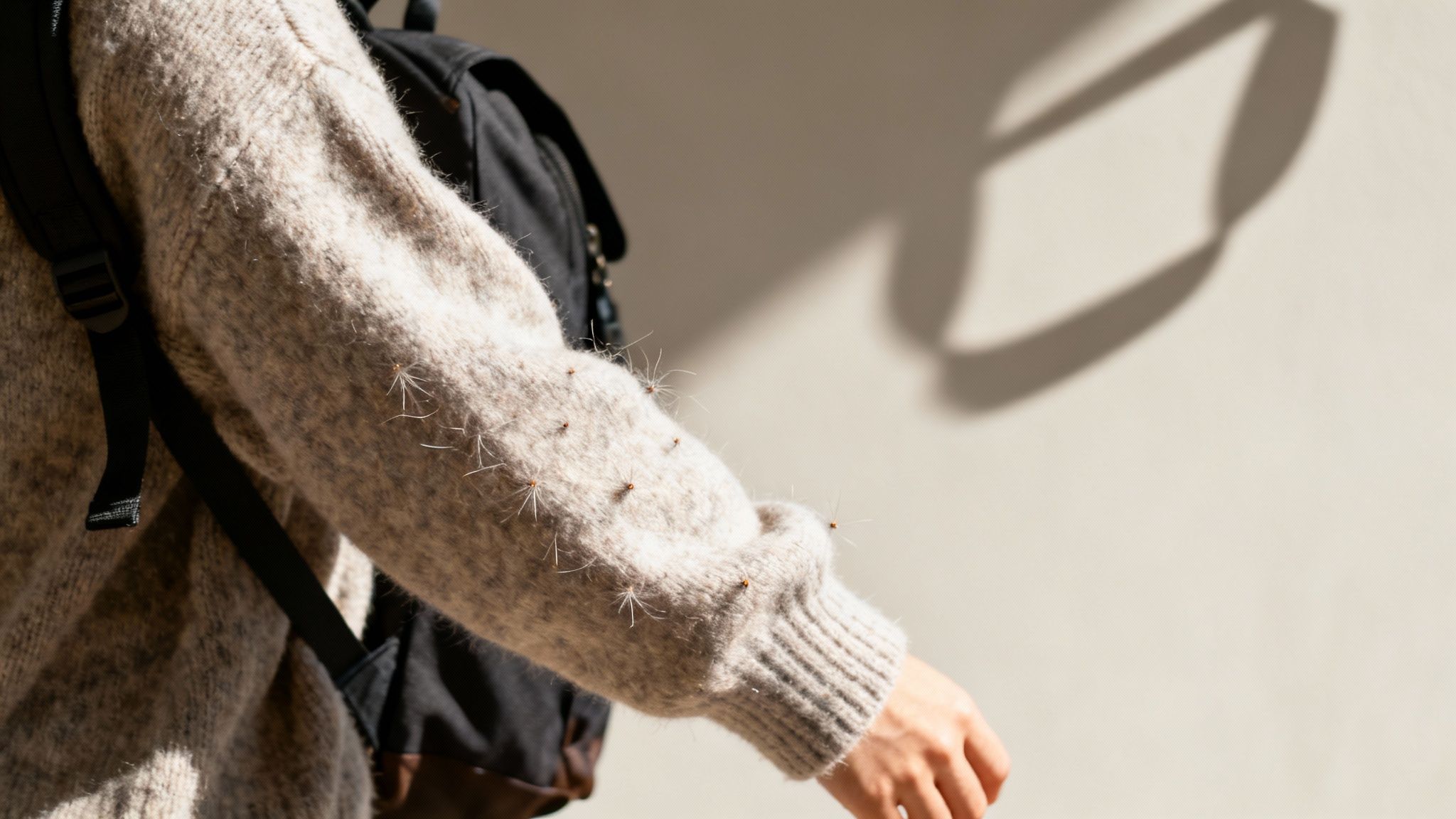
It’s easy to think those little fuzzballs on your favorite sweater mean it’s low-quality, but that’s rarely the case. Pilling isn't a sign of a faulty fabric; it’s the direct result of good old-fashioned mechanical stress.
Think of it as a tiny battle happening on the surface of your clothes every time you move. This constant rubbing and abrasion is the number one trigger for those annoying pills. Every action, from walking to sitting, creates friction that agitates the fabric’s surface, causing the shortest, loosest fibers to break free from the yarn.
Once they're liberated, these fibers get all tangled up with each other, forming the fuzzballs we all know and dislike.
High-Friction Hotspots to Watch
You’ve probably noticed that pilling almost always shows up in the same spots. These are the high-contact zones where our clothes get the most wear and tear from daily life.
- Under the Arms: The constant rubbing of your arms against the sides of a sweater or shirt.
- Between the Thighs: A classic pilling zone for pants and leggings as your legs move.
- Seat and Back: This happens where your clothing rubs against chairs, car seats, or the couch.
- Shoulders and Back: Caused by the straps of a purse, tote bag, or backpack.
The science behind this is crystal clear: friction directly leads to fiber breakage and tangling. It’s a physical process that proves pilling is a natural consequence of using and loving your clothes, not a manufacturing defect.
This isn't just theory; it's a measurable process. Studies on common polyester-cotton blends show that as fabrics get rubbed over and over, the "hairiness" on the surface—the precursor to pills—changes. After just a few hundred rubs, these loose fibers hit their peak length before they start tangling into pills. It's a cycle that confirms friction is the main culprit. If you're interested in the nitty-gritty, you can learn more about the specifics of these textile studies and their findings.
Is Your Laundry Routine Ruining Your Clothes?
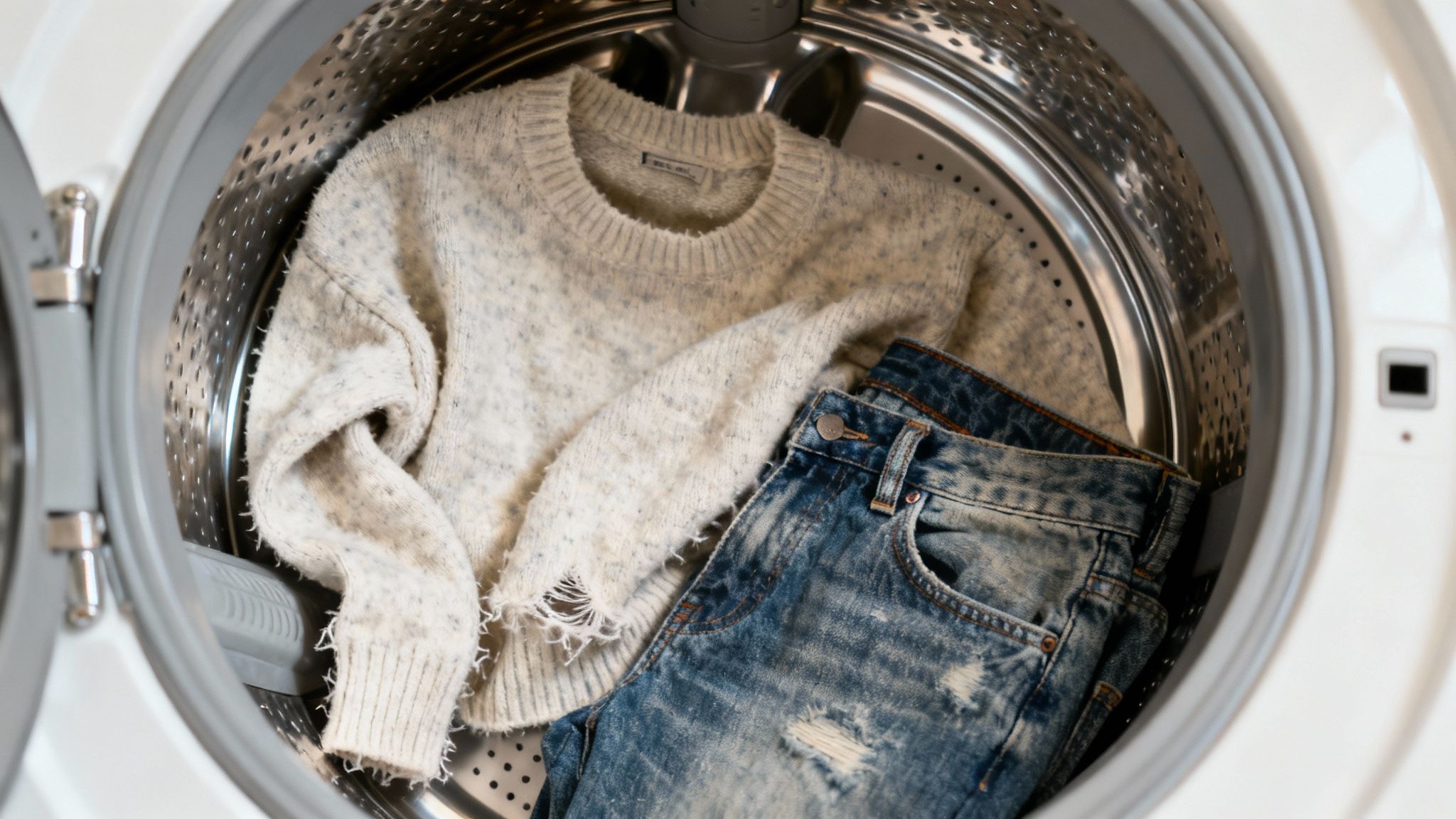
While everyday wear-and-tear is a big part of the pilling puzzle, your laundry room is often where the real damage happens. Think about it: the intense, repetitive rubbing inside a washing machine is the perfect storm for loosening and tangling fibers, especially on your favorite knits and softest fabrics.
And it doesn't stop there. Tossing everything into a hot dryer just makes the problem worse. That combination of tumbling friction and high heat is a fast track to broken fibers, which is what encourages those tiny fuzzballs to form and cling on for dear life.
Another common mistake? Mixing all your fabrics in one load. When you wash a soft sweater with a pair of heavy jeans or a jacket with zippers, you're basically creating a sandpaper effect. The rougher items scrub against the delicate ones, and you can pretty much guarantee a fuzzy, pilled result.
But don't worry—a few simple tweaks can turn your laundry routine from a pilling factory into a fabric-preserving sanctuary.
Your Pill-Proof Laundry Guide
Changing up your laundry habits is hands-down the most effective way to help your wardrobe last. These small adjustments really do add up, keeping your clothes looking smooth and new for so much longer. You might even be surprised to learn that some common practices are actually part of the problem; in fact, there are quite a few laundry myths that have been debunked that could be secretly harming your clothes.
Think of your washing machine as a high-intensity workout for your clothes. For delicate fabrics, a gentle cycle is like a calm yoga session, while a heavy-duty cycle is a full-on CrossFit class—choose wisely based on what your garments can handle.
Start by working these simple, powerful techniques into your routine:
- Turn Garments Inside Out: This is the easiest trick in the book. By turning clothes inside out, you protect the "show" side of the fabric from the harshest friction during the wash.
- Use Mesh Laundry Bags: For your most delicate items—think sweaters, lingerie, or activewear—a mesh bag is a game-changer. It acts as a protective barrier, drastically cutting down on abrasion from other clothes in the load.
- Choose Gentle Cycles and Cold Water: A delicate cycle means less aggressive agitation, and cold water is much kinder to fibers than hot water. This duo is the go-to for fabrics that are prone to pilling.
- Air-Dry Whenever Possible: The high heat and constant tumbling in a dryer are incredibly rough on clothes. Letting your items air-dry is the gentlest method by far, as it completely gets rid of the mechanical friction that causes pills in the first place.
Smarter Shopping: How to Spot Pill-Resistant Fabrics
The best defense against fabric pilling is a good offense—and that starts right in the store. Manufacturers have a few tricks up their sleeves to create more durable, pill-resistant clothes, and learning to spot them can make you a much smarter shopper.
One of the biggest clues is the yarn twist. Picture a tightly wound rope versus a loose one. When the yarn is twisted tightly, the individual fibers are locked securely in place, making it much harder for them to wiggle free and start pilling. You can often feel this difference; a fabric that feels dense, smooth, and tightly woven is usually a good sign. For more tips on identifying materials built to last, our guide to fabrics with longevity is a great resource.
The Power of a Good Finish
Beyond the yarn itself, clothing makers often use special finishing treatments to give fabrics a smoother, more resilient surface. It's like adding a protective topcoat.
- Singeing: This is exactly what it sounds like. The fabric is passed quickly over a flame or a super-hot plate to burn off any of those tiny, fuzzy surface fibers just waiting to ball up.
- Heat Setting: This process, typically used for synthetics, uses heat to lock the fabric's structure into place. It stabilizes the material, making it far less likely to stretch out, distort, or pill.
These behind-the-scenes techniques can make a world of difference. To put it in perspective, let’s look at a common material like polyester-cotton fleece.
Impact of Manufacturing Finishes on Pilling Resistance
Industrial treatments can dramatically improve a fabric's ability to resist pilling. Here’s a look at how a standard fleece fabric can be transformed.
As you can see, that untreated fleece scores a dismal 1 out of 5 on pilling resistance scales. But after getting the proper finishing treatments, that same fabric can jump all the way to a Grade 4. That’s a massive improvement in durability, all thanks to a better finish. If you want to dive into the data, you can explore the research on these finishing techniques for yourself.
Pro Tip: When you're in the store, find a hidden spot on the garment (like an inside seam) and gently rub it with your thumb for about 10 seconds. If you see fuzzing or the beginnings of a pill, consider it a red flag. That fabric probably won't hold up well over time.
Alright, you know what causes those annoying little fuzzballs on your favorite sweater. Now, let’s talk about how to get rid of them—and keep them from coming back. Getting a handle on fabric pills is really a two-part game: dealing with the ones you already have and then playing defense so new ones don’t show up.
When you see pills, your first instinct might be to just pull them off with your fingers. Don't do it! You'll likely just pull out more fibers and make the problem worse down the road. A couple of simple tools can do the job safely, leaving your garment’s surface smooth without causing any extra damage.
The Best Tools for Removing Pills
- Fabric Shaver: These are little electric or battery-powered gadgets that gently shave off pills without snagging the fabric underneath. They’re super fast and work like a charm on most materials.
- Sweater Comb or Stone: This is a great manual option, especially for delicate knits like cashmere or merino wool. It’s designed to gently lift and comb away the pills without being too aggressive.
Once you’ve de-pilled your clothes, the real secret is prevention. A few small tweaks to how you shop and do your laundry can make a world of difference.
Think of it this way: removing pills is like fixing a symptom. But smart care habits get to the root of the problem, helping your favorite clothes last so much longer.
Your Go-To Prevention Checklist
Let's pull everything we've talked about into a simple, easy-to-follow routine.
- Shop Smarter: When you're buying new clothes, look for fabrics with a tight weave. Natural fibers with long filaments, like silk and linen, are fantastic choices because they're naturally less likely to pill.
- Wash with Care: Always turn your garments inside out before washing. Use a gentle cycle with cold water, and pop anything delicate into a mesh laundry bag. This cuts down on a ton of friction in the machine.
- Air-Dry Whenever Possible: The high heat of a tumble dryer is a major culprit for pilling. Letting your clothes air-dry is the gentlest method out there and your number one defense against future fuzz.
Common Questions About Fabric Pilling
So, you've got the basics down, but a few nagging questions might still be floating around. That’s perfectly normal. Let's clear up some of the most common curiosities people have about those pesky fabric pills.
Do All Natural Fibers Pill?
Not at all. It's a common misconception that "natural" means pill-free. The real culprits are short fibers and loose weaves, not whether the material grew on a plant or was made in a lab.
That’s why short-staple natural fibers like cotton and certain wools are prime candidates for pilling. On the flip side, long-staple fibers like silk and linen are incredibly resistant. Their long, continuous threads mean there are far fewer tiny ends to get tangled up in the first place.
Does Pilling Eventually Stop?
In most cases, yes! Pilling is usually at its worst when a garment is brand new. Think of it as the fabric shedding all its shortest, loosest fibers that were trapped during the manufacturing process.
Once these initial fibers have worked their way to the surface and been removed (either by a fabric shaver or just by falling off), the pilling dramatically slows down. For many garments, it practically stops altogether.
A high price tag is not a guarantee against pilling. A garment’s performance is determined by its fabric composition and construction, not its cost. An expensive sweater made from short, loosely spun cashmere can pill more than an affordable, tightly woven synthetic.
Laundry day shouldn't feel like a chore that ruins your clothes. At Columbia Pike Laundry, we handle everything with expert care, giving you back your time and peace of mind. Schedule your first pickup and experience the relief of a laundry-free life at https://columbiapikelaundry.com.
Popular Blog Articles

Meet the Author
Daniel Logan didn’t start CPL because he loved laundry. He started it because his family was drowning in time debt, and laundry was one of the biggest weights.
Mornings were chaos with two kids under 5. Evenings felt like catch-up. And weekends? Gone to sorting socks and folding piles.
He knew his story wasn’t unique. So he built a business that gave families like his just a little bit of breathing room one load at a time.
With no laundry experience but deep tech skills, Daniel rolled up his sleeves, doing every job himself while building systems that turned it into a modern laundry service that saves customers time, simplifies their lives, and delivers reliability they can count on.
That’s where CPL began. Not from a playbook, but from pain. From one dad trying to buy back time: for himself, and for every household like his.


